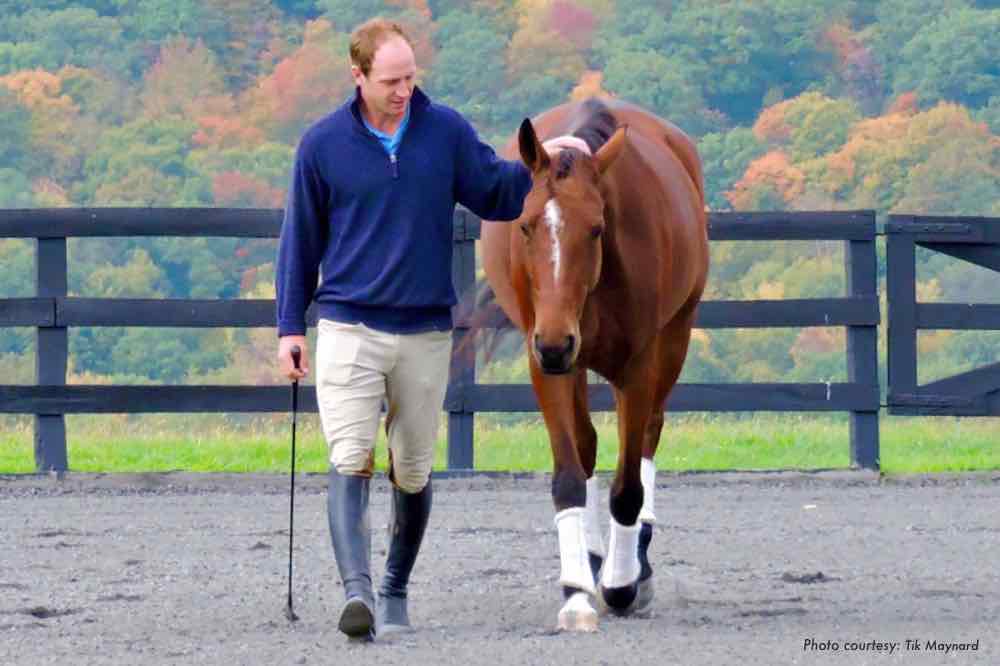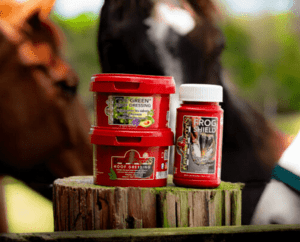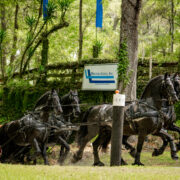Natural Horsemanship Isn’t a Dirty Word

Natural horsemanship wasn’t always billed as a highly-marketed, humane way to train your horse. It didn’t begin in large arenas packed with ticket-buyers who came to see the spectacle of a terrified horse being taught to calmly load into a trailer, or with pricey DVD training sets. These days, there’s a lot of misconception around natural horsemanship, but Tik Maynard isn’t bothered by that.
Tik can often be found with a rope halter in hand, working young horses to seasoned competition horses on the lead line or at liberty in the arena. He has built much of his career as a professional trainer and Advanced-level event rider on the principles of natural horsemanship. He believes that no matter what kind of response the phrase elicits, it all boils down to understanding how horses learn, choosing what works for your horse, and realizing that you know nothing.
“The Right Things at the Right Time”
As professionals have developed prominent training and equipment brands, it’s tempting to categorize natural horsemanship by the techniques and tools used – the unfamiliarity of which may leave riders in traditional english disciplines thinking, ‘That’s not for me.’ But according to Tik, those are shallow ways of defining what is a far more fluid way of viewing the horse.
“It’s how you see yourself with the horse and how you empathize. Do you see yourself as a partner? As a dictator?” said Tik of Citra, Fla., who is also married to CCI5* eventer Sinead Halpin. “The biggest thing for me is understanding how a horse thinks, how a horse is motivated, and how a horse feels. It’s not so much about what you’re doing with them in the moment.”
Great horsemen in various disciplines build their foundation on these principles, Tik says. While it’s not common to see trainers in the english disciplines tagging their training methods as natural horsemanship, more people are using aspects of it without realizing.
“If I look at Steffen Peters, Anne Kursinski or Ingrid Klimke, a lot of them would never use a rope halter, but they are excellent at reading horses and putting horses in situations where they’re going to be successful,” he said. “They are doing the right things at the right time so the horse can understand and enjoy their work.”
The singular goal of natural horsemanship is to make the horse happy in his job, says Tik.
“That’s what riders want their horses to have – natural horsemanship or not. Probably the single biggest thing that makes your horse happy is understanding. What causes things like anxiety and ulcers is when they don’t understand.”
‘Everyone should have a basic understanding of it, the same way riders should have a basic understanding of feeding and hoof care and horse care.’
Applying in Pieces
The groundwork and lunging at liberty that are synonymous with natural horsemanship aren’t necessary for riders who aren’t excited by it. For Tik, a basic understanding of the horse is as far as some folks need to go.
“As far as the groundwork I do – like working with the rope halter and having the horse at liberty – I think it’s a great tool but mostly I do it because I enjoy it,” he said. “But I also think everyone should have a basic understanding of it, the same way riders should have a basic understanding of feeding and hoof care and horse care.”
In a way, Tik says, this way of training has expanded into a discipline in and of itself for those that enjoy it.
“You used to have the hunter/jumpers and the dressage and the cutting horses and the reining, etc., and the horsemanship that you did was just something that you did as a foundation or around everything else,” Tik explained. “Now there’s a demand for the groundwork because a lot of people can’t or don’t want to ride or they get a lot of enjoyment out of it.”
Picking a Program
How can the average rider distinguish between the different brands of natural horsemanship and stay away from frauds and gimmicks? Look at the top people in the program, says Tik, and pick out what you like and ignore what you don’t.
No two trainers that I’ve ever met in my entire life have exactly the same philosophy.
“If you’re judging a program, like you’re looking at the Clinton Anderson program or the Pat Parelli program, you’ve got to be careful not to judge the top people in the program by the bottom people in the program,” he said. “If they did that in dressage it would be like judging the Grand Prix riders by looking at the bottom ten percent of riders doing dressage.”
When evaluating trainers, Tik says to look for happy, bright horses. Learn about the trainer’s technique, theory, and philosophy.
“For people that have been in horses for a long time, [they develop] a philosophy. And I think no two trainers that I’ve ever met in my entire life have exactly the same philosophy – even if you compare David and Karen O’Connor, Pat and Linda Parelli, myself and my wife. It’s like parenting – hardly ever do you see two parents with exactly the same philosophy.”
Finally, it’s important for every horse person to realize that they will always have something else to learn.
“The more I learn, the more I realize I don’t know,” said Tik. “I can spend all day on my farm and I feel like I’m learning more and more every day from the horses. I feel like I know hardly anything at this point.”


